Pear
| Pears | |
|---|---|
 |
|
| European Pear branch with fruit | |
| Scientific classification | |
| Kingdom: | Plantae |
| Division: | Magnoliophyta |
| Class: | Magnoliopsida |
| Order: | Rosales |
| Family: | Rosaceae |
| Subfamily: | Maloideae or Spiraeoideae [1] |
| Tribe: | Pyreae[1] |
| Genus: | Pyrus L. |
| Species | |
|
About 30 species; see text |
|
The pear is a fruit tree of genus Pyrus (pronounced /ˈpaɪrəs/) and also the name of the tree's edible pomaceous fruit.[2] The pear is classified in subtribe Pyrinae within tribe Pyreae and is a perennial. The apple (Malus × domestica), which it resembles in floral structure, is also a member of this subcategory.
The English word “pear” is probably from Common West Germanic *pera, probably a loanword of Vulgar Latin pira, the plural of pirum, akin to Greek api(r)os, which is likely of Semitic origin. The place name Perry can indicate the historical presence of pear trees. The term "pyriform" is sometimes used to describe something which is "pear-shaped".
Contents |
History
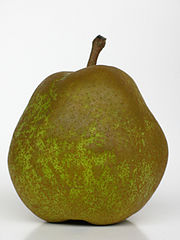
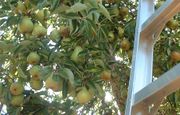
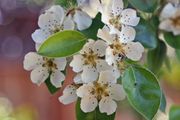
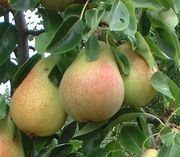
The cultivation of the pear in cool temperate climates extends to the remotest antiquity, and there is evidence of its use as a food since prehistoric times. Many traces of it have been found in the Swiss lake-dwellings. The word “pear”, or its equivalent, occurs in all the Celtic languages, while in Slavonic and other dialects different appellations, but still referring to the same thing, are found—a diversity and multiplicity of nomenclature which led Alphonse de Candolle to infer a very ancient cultivation of the tree from the shores of the Caspian to those of the Atlantic.
Pears grow in the sublime orchard of Alcinous, in Odyssey vii: "Therein grow trees, tall and luxuriant, pears and pomegranates and apple-trees with their bright fruit, and sweet figs, and luxuriant olives. Of these the fruit perishes not nor fails in winter or in summer, but lasts throughout the year."
The pear was cultivated also by the Romans, who did not eat them raw: Pliny's Natural History recommended stewing them with honey and noted three dozen varieties. The Roman cookbook attributed to Apicius, De re coquinaria, has a recipe for a spiced stewed-pear patina, or soufflé (IV.2.35). c A certain race of pears, with white down on the under surface of their leaves, is supposed to have originated from P. nivalis, and their fruit is chiefly used in France in the manufacture of perry (see also cider). Other small-fruited pears, distinguished by their early ripening and apple-like fruit, may be referred to P. cordata, a species found wild in western France, and in Devonshire and Cornwall. Pears have been cultivated in China for approximately 3000 years. The genus is thought to have originated in present-day western China in the foothills of the Tian Shan, a mountain range of Central Asia, and to have spread to the north and south along mountain chains, evolving into a diverse group of over 20 widely recognized primary species . The enormous number of varieties of the cultivated European pear (Pyrus communis subsp. communis), are without doubt derived from one or two wild subspecies (P. communis subsp. pyraster and P. communis subsp. caucasica), widely distributed throughout Europe, and sometimes forming part of the natural vegetation of the forests. In England, where an ancient pear tree gave its name to Pirio (Perry Barr, a district of Birmingham) in Domesday, the pear is sometimes considered wild; there is always the doubt that it may not really be so, but the produce of some seed of a cultivated tree deposited by birds or otherwise, which has germinated as a wild-form spine-bearing tree. Court accounts of Henry III of England record pears shipped from Rochelle and presented to the King by the Sheriffs of London.[3] The French names of pears grown in English medieval gardens suggests that their reputation, at the least, was French; a favored variety in the accounts was named for Saint Rule or Regul', bishop of Senlis.[4]
Asian species with medium to large edible fruit include P. pyrifolia, P. ussuriensis, P. × bretschneideri, P. × sinkiangensis, and P. pashia. Other small-fruited species are frequently used as rootstocks for the cultivated forms.
Botany
Pears are native to coastal and mildly temperate regions of the Old World, from western Europe and north Africa east right across Asia. They are medium sized trees, reaching 10–17 m tall, often with a tall, narrow crown; a few species are shrubby. The leaves are alternately arranged, simple, 2–12 cm long, glossy green on some species, densely silvery-hairy in some others; leaf shape varies from broad oval to narrow lanceolate. Most pears are deciduous, but one or two species in southeast Asia are evergreen. Most are cold-hardy, withstanding temperatures between −25 °C and −40 °C in winter, except for the evergreen species, which only tolerate temperatures down to about −15 °C. The flowers are white, rarely tinted yellow or pink, 2–4 cm diameter, and have five petals.[5] Like that of the related apple, the pear fruit is a pome, in most wild species 1–4 cm diameter, but in some cultivated forms up to 18 cm long and 8 cm broad; the shape varies in most species from oblate or globose, to the classic pyriform 'pear-shape' of the European Pear with an elongated basal portion and a bulbous end.
The fruit is composed of the receptacle or upper end of the flower-stalk (the so-called calyx tube) greatly dilated. Enclosed within its cellular flesh is the true fruit: five cartilaginous carpels, known colloquially as the "core". From the upper rim of the receptacle are given off the five sepals, the five petals, and the very numerous stamens.
The pear is very similar to the apple in cultivation, propagation and pollination. The pear and the apple are also related to the quince.
Pears and apples cannot always be distinguished by the form of the fruit; some pears look very much like some apples. One major difference is that the flesh of pear fruit contains stone cells (also called "grit"). Pear trees and apple trees do have several visible differences. Another interesting difference is that apples, when placed carefully in water, will float; pears will sink.
There are about 30 primary species, major subspecies, and naturally occurring interspecific hybrids of pears.
Major recognized taxa
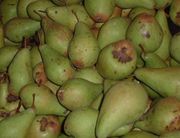
|
Cultivation
The pear may be readily raised by sowing the pips (seeds) of ordinary cultivated or of wilding kinds, these forming what are known as free or pear stocks, on which the choicer varieties are grafted for increase. For new varieties the flowers can be cross-bred to preserve or combine desirable traits. The fruit of the pear is produced on spurs, which appear on shoots more than one year old.
Three species account for the vast majority of edible fruit production, the European Pear Pyrus communis subsp. communis cultivated mainly in Europe and North America, the Chinese white pear (bai li) Pyrus ×bretschneideri, and the Nashi Pear Pyrus pyrifolia (also known as Asian Pear or Apple Pear), both grown mainly in eastern Asia. There are thousands of cultivars of these three species. A species grown in western China, P. sinkiangensis, and P. pashia, grown in southern China and south Asia, are also produced to a lesser degree.
Other species are used as rootstocks for European and Asian pears and as ornamental trees. The Siberian Pear, Pyrus ussuriensis (which produces unpalatable fruit) has been crossed with Pyrus communis to breed hardier pear cultivars. The Bradford Pear (Pyrus calleryana 'Bradford') in particular has become widespread in North America and is used only as an ornamental tree. The Willow-leafed Pear (Pyrus salicifolia) is grown for its attractive slender, densely silvery-hairy leaves.
Harvest
Summer and autumn pears are gathered before they are fully ripe, while they are still green, but snap off when lifted. If left to ripen and turn yellow on the tree, the sugars will turn to starch crystals and the pear will have a gritty texture inside. In the case of the 'Passe Crassane', long the favored winter pear in France, the crop should be gathered at three different times, the first a fortnight or more before it is ripe, the second a week or ten days after that, and the third when fully ripe. The first gathering will come into eating last, and thus the season of the fruit may be considerably prolonged.
Diseases and pests
Production
| Top ten pear producers — 11 June 2008 | ||||
|---|---|---|---|---|
| Country | Production (tonnes) | Footnote | ||
| 12,625,000 | F | |||
| 840,516 | ||||
| 799,180 | ||||
| 537,400 | ||||
| 520,000 | F | |||
| 425,000 | F | |||
| 349,420 | ||||
| 325,000 | F | |||
| 325,000 | F | |||
| 224,000 | F | |||
| World | 20,105,683 | A | ||
| No symbol = official figure, P = official figure, F = FAO estimate, * = Unofficial/Semi-official/mirror data, C = Calculated figure A = Aggregate (may include official, semi-official, or estimates); |
||||
Storage
Pears may be stored at room temperature until ripe.[6] Pears are ripe when flesh around stem gives to gentle pressure.[6] Ripe pears are optimally stored refrigerated, uncovered in a single layer, where they have a shelf life of 2 to 3 days.[6]
Uses
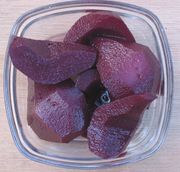
Pears are consumed fresh, canned, as juice, and dried. The juice can also be used in jellies and jams, usually in combination with other fruits or berries. Fermented pear juice is called perry or pear cider.
Pears ripen at room temperature. They will ripen faster if placed next to bananas in a fruit bowl. Refrigerate pears to slow further ripening. Pear Bureau Northwest offers tips on ripening and judging ripeness: While the skin on Bartlett pears changes from green to yellow as they ripen, most varieties show little color change as they ripen. Because pears ripen from the inside out, the best way to judge ripeness is to "Check the Neck." To Check the Neck for ripeness, apply gentle thumb pressure to the neck, or stem end of the pear. If it yields to gentle pressure, then the pear is ripe, sweet, and juicy. If it is firm, leave pear at room temperature and Check the Neck daily for ripeness. Source: Pear Bureau Northwest
The culinary or cooking pear is green but dry and hard and only edible after several hours of cooking. Two Dutch cultivars are "Gieser Wildeman" and "Saint Remy". They are traditionally stewed in wine with spices and served both warm and cold.[7]
Pear wood is one of the preferred materials in the manufacture of high-quality woodwind instruments and furniture. It is also used for wood carving, and as a firewood to produce aromatic smoke for smoking meat or tobacco.
Pear leaves were smoked in Europe before tobacco was introduced.[8][9]
Health benefits
| Nutritional value per 100 g (3.5 oz) | |
|---|---|
| Energy | 242 kJ (58 kcal) |
| Carbohydrates | 15.46 g |
| Sugars | 9.80 g |
| Dietary fiber | 3.1 g |
| Fat | 0 g |
| Protein | 0.38 g |
| Thiamine (Vit. B1) | 0.012 mg (1%) |
| Riboflavin (Vit. B2) | 0.025 mg (2%) |
| Niacin (Vit. B3) | 0.157 mg (1%) |
| Pantothenic acid (B5) | 0.048 mg (1%) |
| Vitamin B6 | 0.028 mg (2%) |
| Folate (Vit. B9) | 7 μg (2%) |
| Vitamin C | 4.2 mg (7%) |
| Calcium | 9 mg (1%) |
| Iron | 0.17 mg (1%) |
| Magnesium | 7 mg (2%) |
| Phosphorus | 11 mg (2%) |
| Potassium | 119 mg (3%) |
| Zinc | 0.10 mg (1%) |
| Percentages are relative to US recommendations for adults. Source: USDA Nutrient database |
|
Pears are an excellent source of dietary fiber and a good source of Vitamin C. According to the FDA's final rule dated July 25, 2006 "Food Labeling; Guidelines for Voluntary Nutrition Labeling of Raw Fruits, Vegetables, and Fish," the nutritional content of a medium-sized fresh pear weighing 166g/5.9oz is as follows:
| Calories | 100 |
| Calories from Fat: | 0 |
| Total Fat: | 0g/0% |
| Saturated Fat: | 0g/0% |
| Trans Fat: | 0g/0% |
| Cholesterol: | 0 mg/0% |
| Sodium: | 0 mg/0% |
| Potassium: | 190 mg/5% |
| Total Carbohydrate: | 26 mg/9% |
| Dietary Fiber: | 6g/24% |
| Sugars: | 16g |
| Protein: | 1g |
| Vitamin A: | 0% |
| Vitamin C: | 10% |
| Calcium: | 2% |
| Iron: | 0% |
Pears are less allergenic than many other fruits, and pear juice is therefore sometimes used as the first juice introduced to infants.[10] However, caution is recommended for all fruit juice consumption by infants as studies have suggested a link between excessive fruit juice consumption and reduced nutrient intake as well as a tendency towards obesity.[11] Pears are low in salicylates and benzoates and are therefore recommended in exclusion diets for allergy sufferers[12]. Along with lamb and rice, pears may form part of the strictest exclusion diet for allergy sufferers[13] although allergies to these foods are possible[14][15][16].
Pears can be useful in treating inflammation of mucous membranes, colitis, chronic gallbladder disorders, arthritis, and gout. Pears can also be beneficial in lowering high blood pressure, controlling blood cholesterol levels, and increasing urine acidity.
In ancient Greece, pears were used to treat nausea.
Most of the fiber is insoluble, making pears a good laxative. The gritty fiber content may cut down on the number of cancerous colon polyps. Most of the vitamin C, as well as the dietary fiber, is contained within the skin of the fruit.[17]
See also
- List of culinary fruits
References
- ↑ 1.0 1.1 Potter, D.; Eriksson, T.; Evans, R.C.; Oh, S.H.; Smedmark, J.E.E.; Morgan, D.R.; Kerr, M.; Robertson, K.R.; Arsenault, M.P.; Dickinson, T.A.; Campbell, C.S. (2007). Phylogeny and classification of Rosaceae. Plant Systematics and Evolution. 266(1–2): 5–43.
- ↑ Sunset Western Garden Book, 1995:606–607
- ↑ Evelyn Cecil, A History of Gardening in England 2006:35ff
- ↑ Cecil 2006.
- ↑ ""Pear Fruit Facts Page Information", CE.CN". http://www.bouquetoffruits.com/fruit-facts/pear-facts.html. Retrieved 2008-06-01.
- ↑ 6.0 6.1 6.2 Canadian Produce Marketing Association > Home Storage Guide for Fresh Fruits & Vegetables Retrieved August 2010
- ↑ Article with recipes on Dutch stewed pears http://davesgarden.com/guides/articles/view/566/
- ↑ Info Tabac: histoire du tabac, accessed 3 June 2010
- ↑ Bertrand Dautzenberg (no date). Epidémiologie des maladies liées au tabac, accessed 3 June 2010
- ↑ "The wonder of pears". FreeDiets. http://www.freediets.com/fruits-vegetables/the-wonder-of-pears.
- ↑ P. Q. Samour, K. K. Helm, C. E. Lang (eds) 2003. Handbook of Pediatric Nutrition, second edition, Aspen Publishers, Inc, Gaithersburg, MD.
- ↑ A. R. Gibson, R. L. Clancy, 1978. An Australian exclusion diet, The Medical Journal of Australia 1:290:292
- ↑ A. Morris 2008 A Guide to Suspected Food Allergy, Surrey Allergy Clinic, U. K.
- ↑ wrongdiagnosis.com, rice allergy
- ↑ wrongdiagnosis.com, lamb allergy
- ↑ wrongdiagnosis.com, pear allergy
- ↑ Phyllis A. Balch, CNC/Prescription for dietary wellness.-2nd ed.
![]() This article incorporates text from a publication now in the public domain: Chisholm, Hugh, ed (1911). Encyclopædia Britannica (Eleventh ed.). Cambridge University Press.
This article incorporates text from a publication now in the public domain: Chisholm, Hugh, ed (1911). Encyclopædia Britannica (Eleventh ed.). Cambridge University Press.
External links
- Pear Varieties - Information about pear varieties grown in California.
- USA Pears—descriptions of pear cultivars from a U.S. advocacy group.
- California Pear Recipes - Over one hundred pear recipes from California Pears.
- Pear Recipes- collection of pear recipes from Pear Bureau Northwest
- University of Georgia Pear Page—History of cultivation and commerce.
- Wild Pear, Pyrus pyraster Diagnostic photos, Morton Arboretum specimens
- European pear varieties, description of Australian commercial pears
|
||||||||||||||